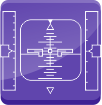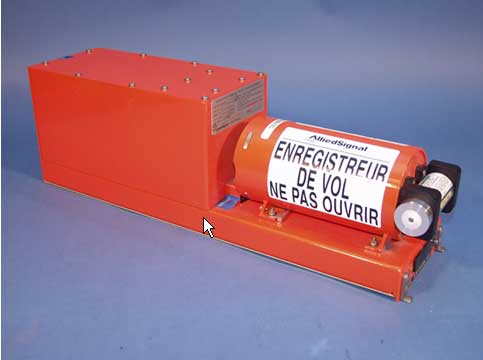| 细节 |
| 送交者: oldfarmer 2022月03月23日09:08:37 于 [世界军事论坛] 发送悄悄话 |
| 回 答: 寄望航空记录仪能承受这么大的冲击.. 由 oldfarmer 于 2022-03-23 08:58:47 |
DescriptionFlight Data Recorder (FDR) - device used to record specific aircraft performance parameters. The purpose of an FDR is to collect and record data from a variety of aircraft sensors onto a medium designed to survive an accident. An FDR has historically been one of two types of "flight recorder" carried on aircraft, the other being a cockpit voice recorder (CVR). Where both types of recorder are fitted, they are now sometimes combined into a single unit (ICAO Definition: Combination recorders). Combination recorders need to meet the flight recorder equipage requirements as specifically detailed in ICAO Annex 6 - Operation of Aircraft. ICAO RequirementsAccording to the provisions in ICAO Annex 6 - Operation of Aircraft, Vol 1 and Vol. III, a Type I FDR shall shall record the parameters required to determine accurately the aeroplane flight path, speed, attitude, engine power, configuration and operation. Types II and IIA FDRs shall record the parameters required to determine accurately the aeroplane flight path, speed, attitude, engine power and configuration of lift and drag devices. The detailed list of parameters to be recorded by FDRs is provided in section 6.3 “Flight recorders” and at Attachement D to Annex 6, Vol. I. Furthermore, provisions in section 6.3 specify the aircraft equipage requirements depending on the maximum certificated take-off mass and the date of first issue of the individual certificate of airworthiness. For example, provision 6.3.6 of Annex 6, Vol. I states that, all aeroplanes of a maximum certificated take-off mass of over 5,700 kg for which the individual certificate of airworthiness is first issued after 1 January 2005 shall be equipped with a Type IA FDR. According to ICAO SARPS, combination recorders (FDR/CVR) can only be used to meet the flight recorder equipage requirements as specifically indicated in ICAO Annex 6 (Vol I and Vol III, Attachment D). ObjectiveThe recorder is installed in the most crash survivable part of the aircraft, usually the tail section. The data collected in the FDR system can help investigators determine whether an accident was caused by pilot error, by an external event (such as windshear), or by an airplane system problem. Furthermore, these data have contributed to airplane system design improvements and the ability to predict potential difficulties as airplanes age. An example of the latter is using FDR data to monitor the condition of a high-hours engine. Evaluating the data could be useful in making a decision to replace the engine before a failure occurs.
Figure 1: Flight Data Recorder, Source: http://www.ntsb.gov HistoryFlight data recorders were first introduced in the 1950s. Many first-generation FDRs used metal foil as the recording medium. This metal foil was housed in a crash- survivable box installed in the aft end of an airplane. Beginning in 1965, FDRs (commonly known as "black boxes") were required to be painted bright orange or bright yellow, making them easier to locate at a crash site. Second-generation FDRs were introduced in the 1970s as the requirement to record more data increased, but they were unable to process the larger amounts of incoming sensor data. The solution was development of the flight data acquisition unit (FDAU). A flight-data acquisition unit is a unit that receives various discrete, analog and digital parameters from a number of sensors and avionic systems and then routes them to a flight data recorder (FDR) and, if installed, to a Quick Access Recorder (QAR). Information from the FDAU to the FDR is sent via specific data frames, which depend on the aircraft manufacturer. Integration of FDAU functions into software required by other aircraft system components is now being seen, as in the case of the Enhanced Airborne Flight Recorder (EAFR) installed on the Boeing 787. The second-generation digital FDR (DFDR) uses tape similar to audio recording tape. The tape is 300 to 500 ft long and can record up to 25 hr of data. It is stored in a cassette device mounted in a crash-protected enclosure. FAA rule changes in the late 1980s required the first-generation FDRs to be replaced with digital recorders. Many of the older FDRs were replaced with second-generation magnetic tape recorders that can process incoming data without a Flight Data Acquisition Unit (FDAU). Most of these DFDRs can process up to 18 input parameters (signals). This requirement was based upon an airplane with four engines and a requirement to record 11 operational parameters for up to 25 hours. Most recent recorders utilise solid state technology. Solid state uses stacked arrays of memory chips, so they don't have moving parts. With no moving parts, there are fewer maintenance issues and a decreased chance of something breaking during a crash. Data from both the cockpit voice recorder (CVR) and FDR is stored on stacked memory boards inside the crash-survivable memory unit (CSMU). The most modern FDR systems incorporate an Emergency Locator Transmitter (ELT) and some up-to-date recorders are also equipped with an Underwater Locator Beacon (ULB) to assist in locating in the event of an overwater accident. A device called a "pinger" is automatically activate when the recorder is immersed in water. It transmits an acoustic signal on a frequency of 37.5 KHz that can be detected with a suitable receiver. In the case of the latest recorders, these transmissions are detectable at all but the most extreme oceanic depths but since they are battery-powered, their transmissions only continue for a limited period. Principles of OperationThe FDR onboard the aircraft records many different operating conditions of the flight. By regulation, newly manufactured aircraft must monitor at least eighty-eight important parameters such as time, altitude, airspeed, heading, and aircraft attitude. In addition, some FDRs can record the status of more than 1,000 other in-flight characteristics that can aid in the investigation. The items monitored can be anything from flap position to auto-pilot mode or even smoke alarms. It is required by regulations that, on an annual basis, an FDR verification check (readout) is performed in order to verify that all mandatory parameters are recorded.
Current Survivability StandardsTSO C123a (CVR) and C124a (DFDR)
Related ArticlesFurther ReadingICAO
NTSB
Others
Category: |
|
|
 |
 |
| 实用资讯 | |
|
|
|
|
| 一周点击热帖 | 更多>> |
| 一周回复热帖 |
| 历史上的今天:回复热帖 |
| 2021: | “大陆打多久台湾就陪多久!”战机频频 | |
| 2021: | 台省2架战机碰撞坠海,路透社又来“甩锅 | |
| 2020: | 这回厉害了 | |
| 2020: | 奇闻共赏 | |
| 2019: | 中国人为什么小时候算术好,但长大了数 | |
| 2019: | 国产轻型多用途通航飞机小鹰-700首飞成 | |
| 2018: | 央视记者王冠跟特朗普算笔账:美国是得 | |
| 2018: | 其实,对进入美济礁12海里的美国军舰就 | |
| 2017: | 台自制潜舰 是一条烧钱的不归路zt | |
| 2017: | 中国现代级驱逐舰改装全解析!136重生啊 | |


